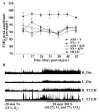Daily acute intermittent hypoxia elicits functional recovery of diaphragm and inspiratory intercostal muscle activity after acute cervical spinal injury
- PMID: 25687551
- PMCID: PMC4716671
- DOI: 10.1016/j.expneurol.2015.02.007
Daily acute intermittent hypoxia elicits functional recovery of diaphragm and inspiratory intercostal muscle activity after acute cervical spinal injury
Abstract
A major cause of mortality after spinal cord injury is respiratory failure. In normal rats, acute intermittent hypoxia (AIH) induces respiratory motor plasticity, expressed as diaphragm (Dia) and second external intercostal (T2 EIC) long-term facilitation (LTF). Dia (not T2 EIC) LTF is enhanced by systemic adenosine 2A (A2A) receptor inhibition in normal rats. We investigated the respective contributions of Dia and T2 EIC to daily AIH-induced functional recovery of breathing capacity with/without A2A receptor antagonist (KW6002, i.p.) following C2 hemisection (C2HS). Rats received daily AIH (dAIH: 10, 5-min episodes, 10.5% O2; 5-min normoxic intervals; 7 successive days beginning 7days post-C2HS) or daily normoxia (dNx) with/without KW6002, followed by weekly (reminder) presentations for 8weeks. Ventilation and EMGs from bilateral diaphragm and T2 EIC muscles were measured with room air breathing (21% O2) and maximum chemoreceptor stimulation (
Mcs: 7% CO2, 10.5% O2). dAIH increased tidal volume (VT) in C2HS rats breathing room air (dAIH+vehicle: 0.47±0.02, dNx+vehicle: 0.40±0.01ml/100g; p<0.05) and MCS (dAIH+vehicle: 0.83±0.01, dNx+vehicle: 0.73±0.01ml/100g; p<0.001); KW6002 had no significant effect. dAIH enhanced contralateral (uninjured) diaphragm EMG activity, an effect attenuated by KW6002, during room air breathing and MCS (p<0.05). Although dAIH enhanced contralateral T2 EIC EMG activity during room air breathing, KW6002 had no effect. dAIH had no statistically significant effects on diaphragm or T2 EIC EMG activity ipsilateral to injury. Thus, two weeks post-C2HS: 1) dAIH enhances breathing capacity by effects on contralateral diaphragm and T2 EIC activity; and 2) dAIH-induced recovery is A2A dependent in diaphragm, but not T2 EIC. Daily AIH may be a useful in promoting functional recovery of breathing capacity after cervical spinal injury, but A2A receptor antagonists (e.g. caffeine) may undermine its effectiveness shortly after injury.
Keywords: Adenosine receptor; Breathing; Intermittent hypoxia; Motor neuron; Spinal cord injury; Spinal plasticity.
Copyright © 2015 Elsevier Inc. All rights reserved.
Figures








Similar articles
-
Enhanced recovery of breathing capacity from combined adenosine 2A receptor inhibition and daily acute intermittent hypoxia after chronic cervical spinal injury.Exp Neurol. 2017 Jan;287(Pt 2):93-101. doi: 10.1016/j.expneurol.2016.03.026. Epub 2016 Apr 11. Exp Neurol. 2017. PMID: 27079999 Free PMC article.
-
Adenosine 2A receptor inhibition enhances intermittent hypoxia-induced diaphragm but not intercostal long-term facilitation.J Neurotrauma. 2014 Dec 15;31(24):1975-84. doi: 10.1089/neu.2014.3393. Epub 2014 Sep 26. J Neurotrauma. 2014. PMID: 25003645 Free PMC article.
-
Recruitment and plasticity in diaphragm, intercostal, and abdominal muscles in unanesthetized rats.J Appl Physiol (1985). 2014 Jul 15;117(2):180-8. doi: 10.1152/japplphysiol.00130.2014. Epub 2014 May 15. J Appl Physiol (1985). 2014. PMID: 24833779 Free PMC article.
-
Prolonged acute intermittent hypoxia improves forelimb reach-to-grasp function in a rat model of chronic cervical spinal cord injury.Exp Neurol. 2021 Jun;340:113672. doi: 10.1016/j.expneurol.2021.113672. Epub 2021 Feb 27. Exp Neurol. 2021. PMID: 33652030 Review.
-
Serotonergic innervation of respiratory motor nuclei after cervical spinal injury: Impact of intermittent hypoxia.Exp Neurol. 2021 Apr;338:113609. doi: 10.1016/j.expneurol.2021.113609. Epub 2021 Jan 15. Exp Neurol. 2021. PMID: 33460645 Free PMC article. Review.
Cited by
-
Therapeutic Strategies Targeting Respiratory Recovery after Spinal Cord Injury: From Preclinical Development to Clinical Translation.Cells. 2023 May 31;12(11):1519. doi: 10.3390/cells12111519. Cells. 2023. PMID: 37296640 Free PMC article. Review.
-
Low level CO2 supplementation maintains isocapnia and reveals ventilatory long-term facilitation in rats.Respir Physiol Neurobiol. 2024 Feb;320:104185. doi: 10.1016/j.resp.2023.104185. Epub 2023 Nov 5. Respir Physiol Neurobiol. 2024. PMID: 37935342 Free PMC article.
-
Cervical spinal injury compromises caudal spinal tissue oxygenation and undermines acute intermittent hypoxia-induced phrenic long-term facilitation.Exp Neurol. 2021 Aug;342:113726. doi: 10.1016/j.expneurol.2021.113726. Epub 2021 Apr 26. Exp Neurol. 2021. PMID: 33915165 Free PMC article.
-
Respiratory plasticity following spinal cord injury: perspectives from mouse to man.Neural Regen Res. 2022 Oct;17(10):2141-2148. doi: 10.4103/1673-5374.335839. Neural Regen Res. 2022. PMID: 35259820 Free PMC article. Review.
-
Bio-Inspired Controller on an FPGA Applied to Closed-Loop Diaphragmatic Stimulation.Front Neurosci. 2016 Jun 16;10:275. doi: 10.3389/fnins.2016.00275. eCollection 2016. Front Neurosci. 2016. PMID: 27378844 Free PMC article.
References
-
- Bach KB, Mitchell GS. Hypoxia-induced long-term facilitation of respiratory activity is serotonin dependent. Respir Physiol. 1996;104:251–260. - PubMed
-
- Berntson GG, Jang JF, Ronca AE. Brainstem systems and grooming behaviors. Annals of the New York Academy of Sciences. 1988;525:350–362. - PubMed
-
- Bertelli JA, Mira JC. Behavioral evaluating methods in the objective clinical assessment of motor function after experimental brachial plexus reconstruction in the rat. Journal of neuroscience methods. 1993;46:203–208. - PubMed
Publication types
MeSH terms
Substances
Grants and funding
LinkOut - more resources
Full Text Sources
Other Literature Sources
Medical
Miscellaneous

